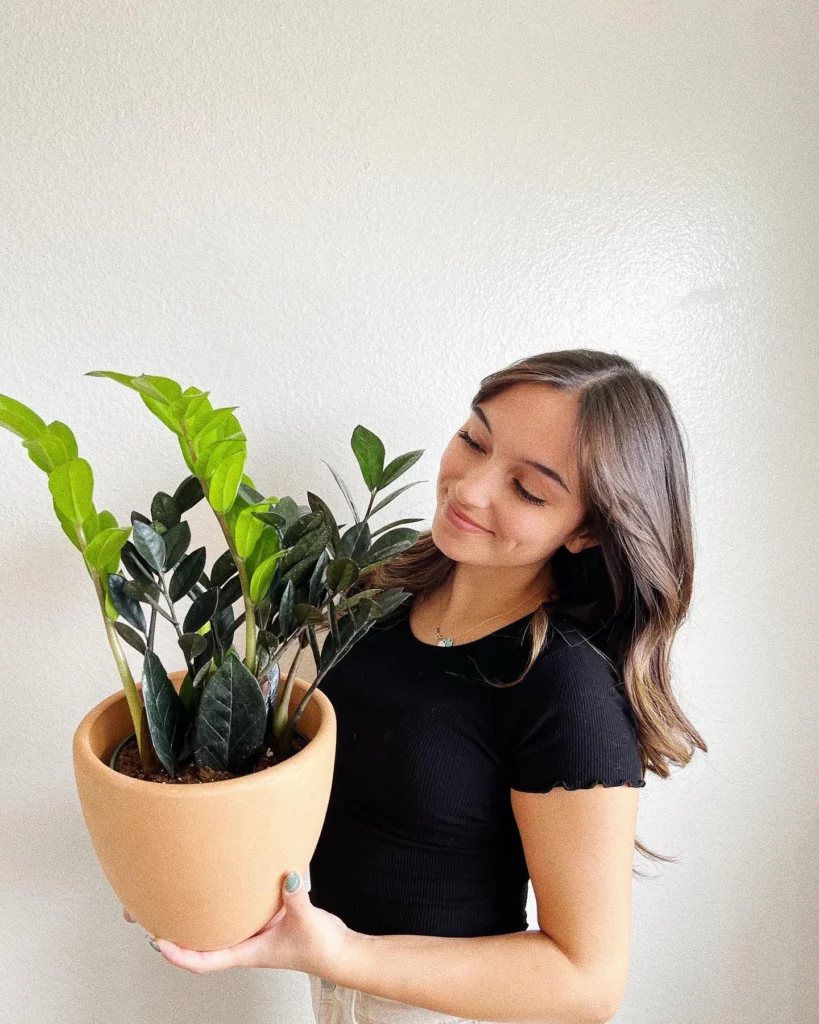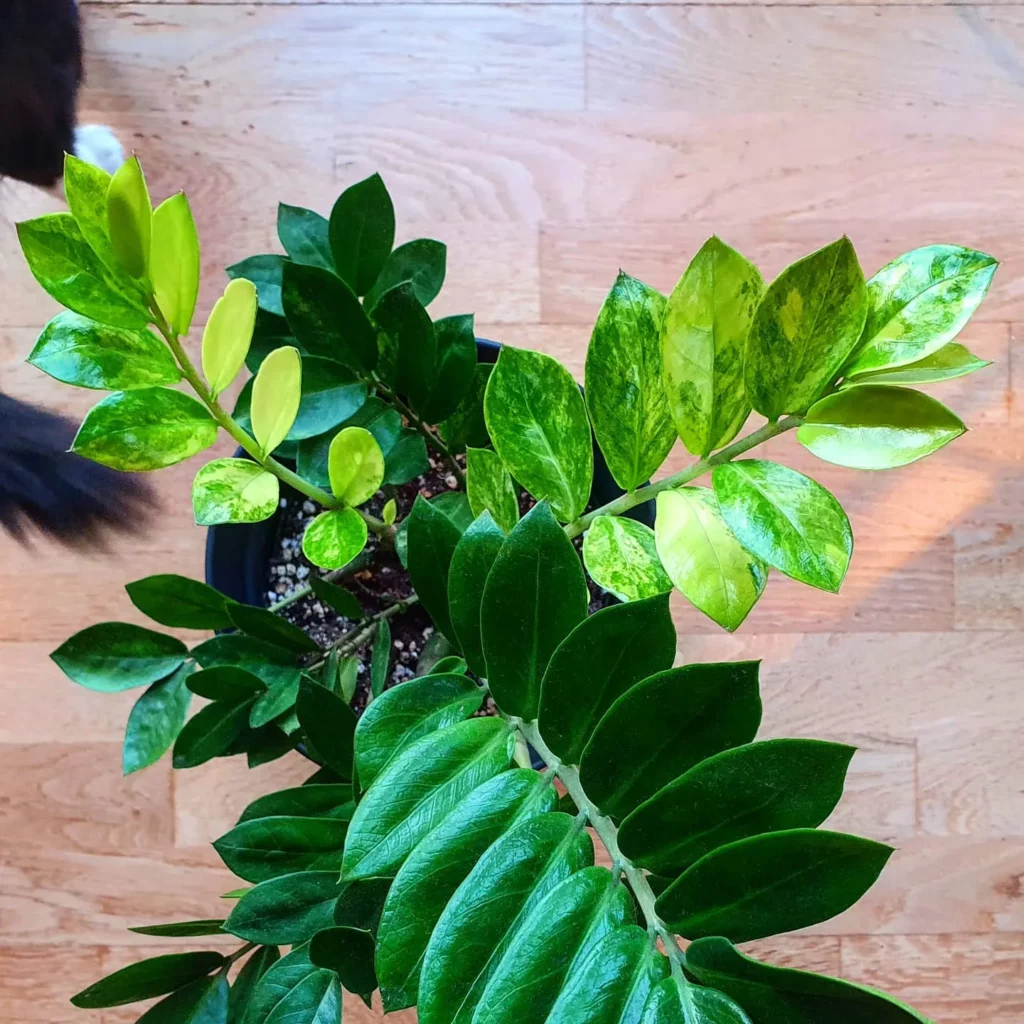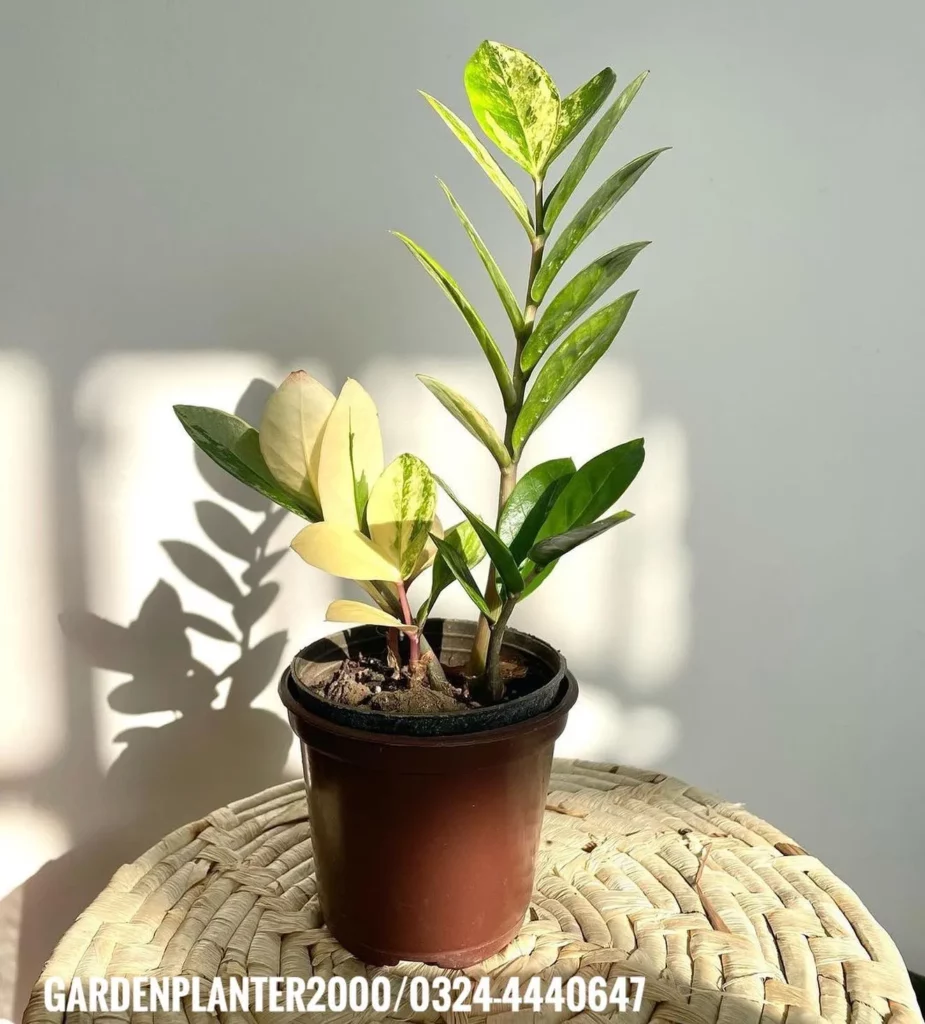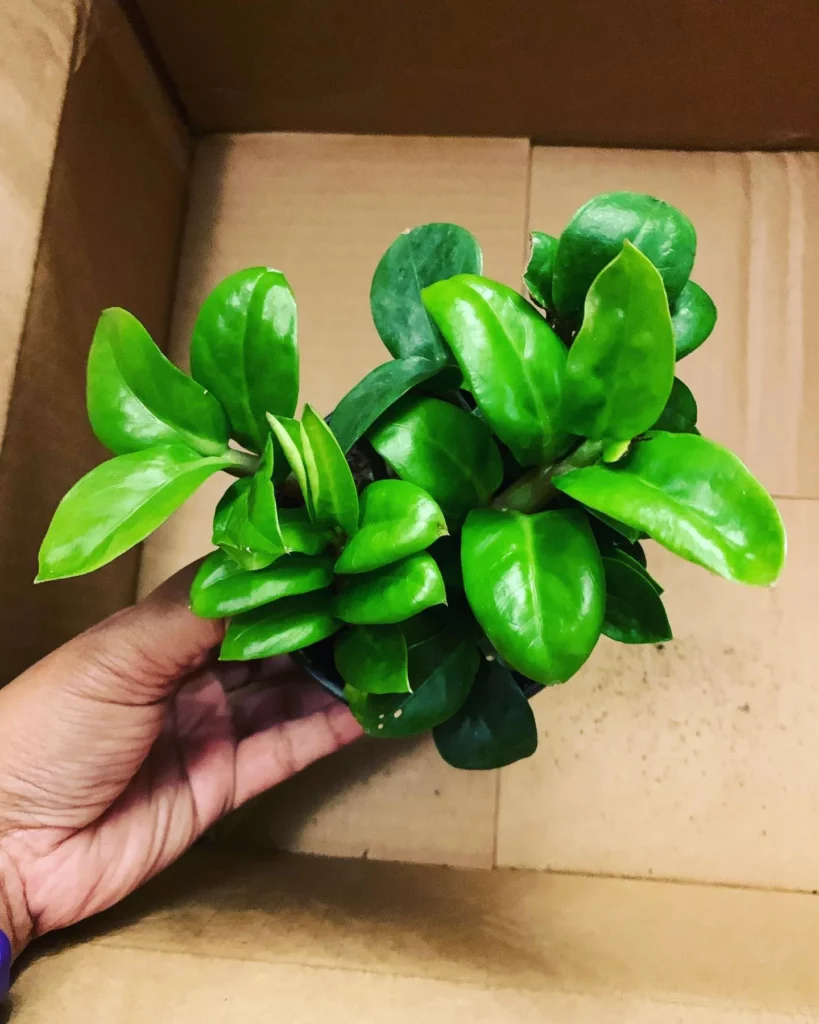Healthy ZZ Plants thrive in temperatures between 60-75°F (15-24°C) and prefer humidity levels of 40-50%, though they are adaptable to a range of indoor conditions.
ZZ plants thrive in temperatures of 65-85°F and prefer humidity levels of 40-50%, adapting well to indoor environments. These resilient plants require medium to bright indirect light and minimal watering, allowing the soil to dry between sessions.
To prevent issues like root rot or browning leaf tips, maintaining these conditions alongside avoiding overwatering and direct sunlight is key. While easy to care for and capable of growing up to three feet tall, it’s important to note they are not pet-friendly.
No products found.
Optimal Climate For ZZ Plants

ZZ plants, native to Eastern Africa, have adapted to a range of growing conditions across various climates. These low-maintenance indoor plants thrive in optimal climate conditions that resemble their natural habitat.
To create the perfect environment for your ZZ plants, it’s essential to consider factors such as temperature, humidity, light, and watering.
When it comes to temperature, ZZ plants prefer average indoor temperatures between 65 and 85 degrees Fahrenheit. They can tolerate temperatures as low as 45 degrees Fahrenheit but should not be exposed to prolonged cold conditions.
It’s important to protect them from drafts and ensure they are not placed near cold windows or doors. On the other hand, extreme heat can also be detrimental to their health, so it’s best to avoid placing them in direct sunlight or near radiators.
Humidity is another crucial factor for ZZ plants. While they naturally grow in areas with varying humidity levels, they prefer average indoor humidity levels between 40 and 50 percent.
This can be achieved by grouping plants together, using pebble trays filled with water, or using a humidifier. However, it’s important to avoid excessive moisture, as it can lead to mold and root rot.
No products found.
Keep in mind that low humidity can cause browning leaf tips, so finding the right balance is key.
Light conditions also play a significant role in the growth of ZZ plants. They thrive in medium to bright indirect light, making them perfect for indoor spaces away from direct sunlight.
Placing them near a north or east-facing window is ideal, as they can benefit from the gentle morning or afternoon sun. If you notice that your ZZ plant is not getting enough light, you can supplement it with artificial grow lights.
Temperature Requirements

ZZ plants thrive in average indoor temperatures between 65 and 85 degrees Fahrenheit. They are resilient and can tolerate a wide range of temperature conditions, making them popular choices for indoor gardening.
These plants have evolved to adapt to various climates in their native habitat of Eastern Africa, from dry forests to humid evergreen forests.
However, it is important to avoid exposing ZZ plants to temperatures below 45 degrees Fahrenheit for extended periods, as it can cause damage to their foliage and overall health.
No products found.
To ensure the optimal growth and well-being of ZZ plants, it is crucial to provide consistent temperatures within their preferred range. Fluctuations in temperature can stress the plants and affect their ability to thrive.
It is advisable to place ZZ plants away from drafty areas, such as windows and doors, as sudden temperature changes can have a negative impact on their growth.
In addition to maintaining the appropriate temperature range, it is important to protect ZZ plants from direct sunlight and intense heat. While they prefer medium to bright indirect light, direct sunlight can scorch their leaves and cause irreversible damage.
Therefore, it is recommended to place ZZ plants in areas where they can receive filtered light or in rooms with bright, indirect natural light.
It is worth noting that every indoor environment is different, and the temperature requirements for ZZ plants may vary slightly depending on factors such as humidity levels, air circulation, and overall climate conditions.
Humidity Preferences

ZZ plants prefer indoor humidity levels between 40 and 50 percent for optimal growth. While they can tolerate a wide range of humidity conditions, maintaining a moderate humidity level within this range helps promote their overall health and appearance.
High humidity can lead to the development of mold and root rot, while low humidity can cause the tips of their leaves to turn brown.
To ensure the ideal humidity for your ZZ plant, there are a few methods you can employ. One option is to group your plants together, as they collectively release moisture into the air through transpiration, creating a more humid microclimate.
No products found.
Placing your ZZ plant on a tray filled with pebbles and water can also help increase humidity. As the water evaporates, it creates moisture in the air surrounding the plant.
Additionally, using a humidifier in the room where your ZZ plant is located can help maintain the desired humidity level.
It’s important to note that while ZZ plants prefer moderate humidity, they are fairly adaptable and can tolerate slight fluctuations. However, consistently providing humidity levels within the recommended range will help ensure their optimal growth and vitality.
By monitoring and adjusting the indoor humidity of your ZZ plant’s environment, you can create a more favorable condition for its overall well-being.
Light Conditions

ZZ plants thrive in medium to bright indirect light and should be protected from direct sunlight. As native to Eastern Africa, where they grow in diverse habitats ranging from grasslands to humid evergreen forests, ZZ plants have adapted to various light intensities.
They can tolerate lower light conditions but will thrive and grow more vigorously in brighter light. Placing your ZZ plant near a north, east, or west-facing window is ideal, as they will receive the right amount of sunlight without being exposed to the harsh midday sun.
No products found.
When it comes to indoor lighting, ZZ plants can also adapt well to artificial lights. If you don’t have access to natural light, using fluorescent or LED grow lights can provide the necessary light intensity for their growth.
Position the lights about 12 to 18 inches away from the plant to mimic natural light conditions. Keep in mind that ZZ plants are not suited for direct exposure to intense, full sun, as it can scorch their leaves.
Signs of Inadequate Light
If your ZZ plant is not receiving enough light, it will start to show signs of inadequate lighting. The most common signs include stunted growth, leaf elongation, and a lack of new growth.
The plant may also appear leggy or have smaller leaves. If you notice these signs, it’s a good indication that your ZZ plant needs more light. Consider moving it to a brighter location or providing supplemental artificial lighting to support its growth.
Watering and Care Tips

ZZ plants have low water requirements and should be watered every 2-3 weeks, allowing the soil to dry out between waterings. Overwatering can lead to root rot, so it’s important not to overdo it.
To determine when to water your ZZ plant, simply insert your finger about an inch into the soil. If it feels dry, it’s time to water. If it still feels moist, it’s best to wait a little longer.
When watering your ZZ plant, it’s important to pour water directly into the soil rather than on the leaves. This helps prevent moisture-related diseases and keeps the plant’s foliage healthy.
It’s also a good idea to use room temperature water, as cold water can shock the roots and hinder their growth.
In addition to proper watering, ZZ plants benefit from regular fertilization. Use a balanced, water-soluble fertilizer formulated for houseplants.
Apply the fertilizer according to the instructions on the packaging, typically every 2-3 months during the growing season. Be careful not to exceed the recommended dosage, as this can burn the plant’s roots.
“ZZ plants have low water requirements and should be watered every 2-3 weeks, allowing the soil to dry out between waterings.”
Temperature Tolerance and Protection

ZZ plants can tolerate temperatures between 65 and 85 degrees Fahrenheit but should not be exposed to temperatures below 45 degrees Fahrenheit for extended periods.
It is important to protect them from extreme cold, as prolonged exposure to low temperatures can damage their foliage and stunt their growth. If you live in a region with colder winters, it is advisable to bring your ZZ plant indoors or provide adequate protection, such as covering it with a frost cloth or moving it to a warmer location.
To ensure the optimal temperature for your ZZ plant, it is recommended to place it in a room with stable temperatures and away from drafts, heating vents, or air conditioning units.
Sudden temperature fluctuations can stress the plant and affect its overall health. Maintaining a consistent temperature within the preferred range of 65 to 85 degrees Fahrenheit will help promote healthy foliage, growth, and overall well-being.
If you notice signs of temperature stress in your ZZ plant, such as yellowing or browning leaves, wilting, or slowed growth, it may indicate that the plant is experiencing temperature-related issues.
Adjusting the placement of the plant or providing additional insulation can help alleviate these symptoms. Regularly monitoring the temperature in the plant’s environment is crucial for maintaining its health and preventing temperature-related problems.
Conclusion

Providing the right temperature and humidity conditions is crucial for maintaining the health and thriving of ZZ plants. These low-maintenance indoor plants, also known as Zamioculcas zamiifolia, can tolerate a range of climate conditions, making them ideal for indoor cultivation.
ZZ plants prefer average indoor temperatures between 65 and 85 degrees Fahrenheit, ensuring they thrive in a comfortable environment. They have evolved to tolerate varying conditions in their native habitats, including grasslands, dry forests, riverbanks, and bushy thickets.
However, it is important to avoid exposing them to temperatures below 45 degrees Fahrenheit for extended periods, as it can negatively impact their growth.
Average indoor humidity levels between 40 and 50 percent are suitable for ZZ plants. While they prefer drier rather than wetter conditions, they can adapt to a wide range of humidity levels.
However, excessive humidity can lead to mold and root rot, while low humidity can cause browning leaf tips. Maintaining humidity levels between 40 and 50 percent is recommended for optimal ZZ plant health.
In addition to temperature and humidity, ZZ plants also have specific light and watering requirements. They thrive in medium to bright indirect light and should be protected from intense, direct sunlight.
Overwatering can cause root rot, so it is important to water ZZ plants every 2-3 weeks, allowing the soil to dry out between waterings.
With proper care, ZZ plants can grow up to two or three feet tall and wide indoors. They are relatively easy to care for but should be kept away from pets, as the foliage can be irritating when consumed.
Make sure to check out our article on How To Fertilize ZZ Plants For Lush Growth. And after reading that ZZ Plant article, check out our article on Common Mistakes To Avoid With ZZ Plant Care.
FAQ
Q: What is the ideal temperature range for ZZ plants?
A: ZZ plants prefer average indoor temperatures between 65 and 85 degrees Fahrenheit.
Q: What is the optimal humidity level for ZZ plants?
A: ZZ plants prefer average indoor humidity levels between 40 and 50 percent.
Q: Can ZZ plants tolerate a wide range of humidity levels?
A: Yes, ZZ plants can tolerate a wide range of humidity levels, but excessive humidity can lead to mold and root rot, while low humidity can cause browning leaf tips.
Q: How can I increase humidity for my ZZ plants?
A: You can increase humidity by grouping plants together, placing plants on trays of pebbles filled with water, or using a humidifier.
Q: What kind of light conditions do ZZ plants prefer?
A: ZZ plants prefer medium to bright indirect light and should be protected from intense, direct sunlight.
Q: How often should I water my ZZ plants?
A: ZZ plants have low water requirements and should be watered every 2-3 weeks, allowing the soil to dry out between waterings.
Q: What happens if I overwater my ZZ plants?
A: Overwatering can cause root rot in ZZ plants.
Q: What is the temperature tolerance of ZZ plants?
A: ZZ plants can tolerate temperatures between 65 and 85 degrees Fahrenheit but should not be exposed to temperatures below 45 degrees Fahrenheit for extended periods.
Q: How tall and wide can ZZ plants grow indoors?
A: ZZ plants can grow up to two or three feet tall and wide indoors.
Q: Are ZZ plants pet-friendly?
A: No, ZZ plants are not pet-friendly as their foliage can be irritating when consumed.





